 Image search results - "ice" Image search results - "ice" |

Hinohara Village Office. For a small village, this is a grand building. 檜原村役場
|
|

Practice
|
|

Drawing of Hinohara Castle
|
|
|

Inside Hinohara Village Office
|
|

Me next please!!!The winner gets to decide who to wrestle next. The rikishi all beg to be picked.
|
|

Hinohara Village Office has a coffee shop.
|
|

The Bulgarian (Kotooshu) on the left
|
|

Made in Hinohara, displayed in the coffee shop.
|
|

Jam made in Hinohara.
|
|

Ready to pounce on the winner
|
|

The Village Office and coffee shop has a great view of the river.
|
|
|
|

Hinohara village manhole
|
|
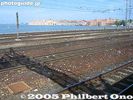
Train bridge to Venice
|
|

Hinohara Village Tourist Info Office
|
|

Inside Hinohara Village Tourist Info Office
|
|

Both ozeki watch
|
|
|

Rice storehouse
|
|
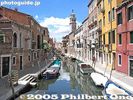
Venice ヴェネツィアは、どこへ行っても絵はがきの風景Everywhere you go in Venice looks like a picture postcard. A photographer's paradise. It's an impossible place. Too many things to see, and you can never see them all.
|
|
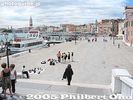
Venice waterfrontYou can walk along the waterfront to go to the Venice Biennale site.
|
|
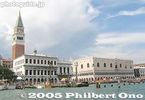
St. Mark's Square and Palazzo Ducale seen from the boatYou can also take a boat down the canal to go to the Venice Biennale site.
|
|
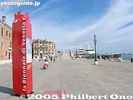
Venice Biennale marker
|
|
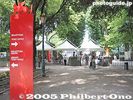
Entrance to Venice Biennale at Giardini ヴェネツィア・ビエンナーレの入口The Venice Biennale has two main sites: The lush and garden-like Giardini and the Arsenale, a short walk away. Other venues (mainly country pavilions) are scattered around Venice.
ヴェネツィア・ビエンナーレは、二つのメイン会場があって、一つはこの緑豊かなガーディニ会場。ここは、いろいろの国のパビリオンがある。イタリヤ館も日本館がここにあります。
|
|

Giant kagami mochi, rice cake in the Haiden Hall. Over 2 meters tall and over 2 meters diameter. Weighs 4 tons. They are to be cut into small pieces (with a chain saw) and given away the next morning.
|
|

More giant mochi offered to the shrine. Notice the forklift. 大鏡餅奉納
|
|

Giant mochi inside the Haiden hall. 大鏡餅奉納
|
|

Closeup of giant mochi. Solid as a rock.
|
|
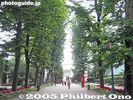
Venice Biennale at GiardiniThe Giardini site has country pavilions that are permanent buildings. Most of the major countries are represented by their own pavilions. This is the path to the Italian Pavilion, the largest one of all.
|
|

Falling Down LaughingSculpture seen on the way to the Italian Pavilion.
|
|

Italian Pavilion イタリア館The Italian Pavilion was the largest of all, featuring numerous exhibition rooms and numerous artists.
イタリア館が最大のパビリオン。
|
|
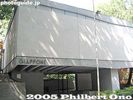
Japan Pavilion 日本館The Japan Pavilion is also in the Giardini site.
まったく地味な建物で、全然日本らしくありません。
|
|
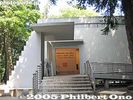
Japan Pavilion entrance 日本館の入口
|
|
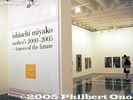
Japan Pavilion showing Miyako Ishiuchi 日本館は、30年ぶりに写真家が出品:石内都The last time a Japanese photographer held a solo show at the Venice Biennale's Japan Pavilion was in 1976 with Kishin Shinoyama. Almost 30 years later, we finally have a photographer as Japan's featured artist. She is Miyako Ishiuchi.
Her exhibition was titled: mother's 2000-2005--traces of the future. This is a series of photos of her deceased mother's personal effects--clothing, lipstick, kimono, etc.
A catalog of the same name was also published and sold in the pavilion. They also had sample copies of her other photo books (all in Japanese), but only the catalog was for sale.
写真家が単独で日本代表となるのは、1976年の篠山紀信以来です。今回の第51回のヴェネツィア・ビエンナーレに石内都が出品したのは、2000年に亡くなった母の遺品を撮った「Mother's」シリーズ。服、ヘアブラシ、口紅、といった品々が主の不在を静かに訴えかける。計35点。
|
|
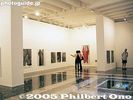
Japan Pavilion showing Miyako Ishiuchi 日本館内Most of the photos showed the personal effects of her deceased mother. Sticks of lipstick, clothing, kimono, etc. A video monitor on the floor showed her photos of Yokosuka.
|
|
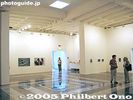
Japan Pavilion showing Miyako Ishiuchi 日本館内The pavilion was well attended.
|
|

Swiss Pavilion スイス館
|
|
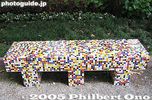
Park bench
|
|
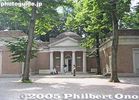
US Pavilion アメリカ館A few big rooms with white walls and paintings.
幾つかの大きい部屋に絵画。
|
|
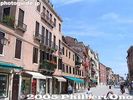
Near the ArsenaleAnother picture postcard street.
|
|

Path to Arsenale
|
|
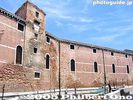
Arsenale アーセナレ会場The Arsenale is a huge, long building housing various art works by 49 artists.
アーセナレ会場は、細長い、とてもでっかい建物の中に個人のアーティストの作品が展示。
|
|
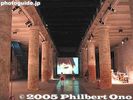
Inside the Arsenale アーセナレの中
|
|

Hippo in the Arsenale
|
|
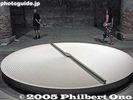
By Mona HatoumThe center bar rotates around as it makes ridges and flattens them.
|
|
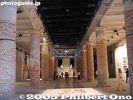
Inside the Arsenale
|
|

Photo exhibition in Arsenale
|
|

Pay phones housed by birds, by Sergio VegaOutside the Arsenale there were these pay phones.
|
|
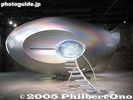
Mariko Mori at the Arsenale 森 万里子のUFOHer trademark UFO.
|
|
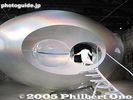
Mariko Mori 中にも入れるThree people at a time could go inside and watch some kind of video.
三人が入れる。
|
|
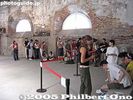
Line to enter Mariko Mori's UFO UFOに入るために並んでいる
|
|
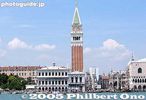
St. Mark's Square and Campanile
|
|
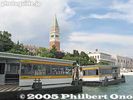
Boat landing for St. Mark's Square
|
|
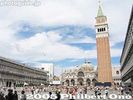
Piazza San Marco or St. Mark's Square ヴェネツィアの中心であるサンマルコ広場The heart of Venice and where all the tourists are. The square is lined with shops and restaurants. Public toilets cost money.
|
|
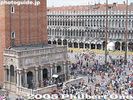
St. Mark's Square and entrance to the CampanileIt doesn't take long to go up the elevator to the top of the tower. It was surprisingly uncrowded, unlike St. Mark's Basilica where there was a long line at all times.
|
|
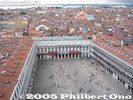
View from Campanile 鐘楼の展望台からの風景The tower provided magnificent views of the square and the entire island of Venice.
|
|
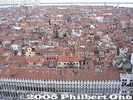
View from Campanile 鐘楼からの風景
|
|
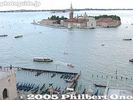
View from Campanile - San Giorgio island 鐘楼からの風景
|
|

Bell ringing on Campanile 鐘楼が鳴らし始めたWe asked if the bells were actually rung. The answer was yes. And it was to ring next at 6:30 pm. So we waited 15 min., and sure enough two of the bells started to ring, jerking back and forth. It wasn't as loud as you would think.
鐘楼の上にいたとき、偶然に鐘が鳴らし始めた(午後6:30).
|
|

Palazzo Ducale inner courtyardThe Palazzo Ducale next to St. Mark's Square is truly magnificent. The rooms have very ornate paintings and carvings. It was not crowded at all compared with St. Mark's Basilica which was just too crowded with people.
|
|

Grand Canal and Ponte di Rialto bridgeThis is the main bridge crossing the Grand Canal. The middle of the bridge has a row of shops.
|
|
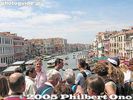
Atop Ponte di Rialto bridgeThis is one of three bridges crossing the Grand Canal.
|
|
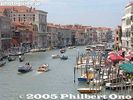
View from Ponte di Rialto bridge
|
|
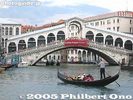
Ponte di Rialto bridge and gondola
|
|
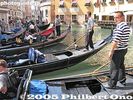
Gondola stationA gondola ride is not exactly cheap, but affordable with 5 or 6 people.
|
|

Gondola
|
|
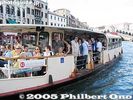
Common boatThis is one of the most common means of public transportation in Venice. Many of the canals have heavy boat traffic.
|
|
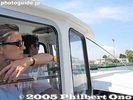
Boat crew
|
|

Boat captain
|
|
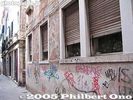
Graffiti even in Venice 落書きThere was graffiti almost everywhere I went in Italy. Sadly, even in Venice.
イタリアは落書きが多い。ヴェネツィアにも結構ある。
|
|

University of Venice ヴェネツィア大学
|
|

University of Venice library ヴェネツィア大学の図書室
|
|

University of Venice classroom ヴェネツィア大学の教室
|
|

University of Venice, Japanese Dept. ヴェネツィア大学の日本語学科Building housing the Japanese Department. It faces a canal.
|
|
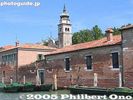
Building along the canal
|
|

Venetian food ヴェネツィアの料理
|
|
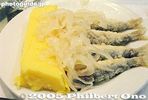
Venetian food ヴェネツィアの料理
|
|

Grilled veggies
|
|

Venice train station ヴェネツィアの駅The walk between the bus station and train station is a little longer than you would like it to be.
|
|
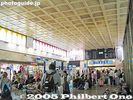
Inside Venice station ヴェネツィアの駅
|
|
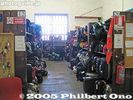
Luggage storage room ヴェネツィアの駅の荷物預かり所Coin-operated lockers were out of order in the station. In the morning at 9:30 am, the line can be long for people wanting to store their baggage.
|
|
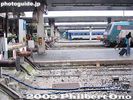
Venice Station train platforms ヴェネツィアの駅のホーム
|
|

Train to Milan (back end) ヴェネツィアの駅(ミラノへの電車)
|
|

Inside the train to Milan ミラノへの電車
|
|

View of Mt. Mikami-yama amid rice paddies in Yasu. Elevation 432 meters.
|
|
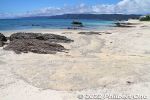
This beach had pumice rocks (軽石) creating artistic patterns on the sand. They were still washing up on the beach in June 2022, but not as much as in Oct. 2021 when they clogged harbors and blanketed beaches.
|
|

On Amami-Oshima, Kagoshima, Amami Resort Basyayama-mura beach had pumice that came from an undersea volcano (Fukutoku-Okanoba) erupting near the Ogasawara islands (way south of Tokyo).
|
|
|
|
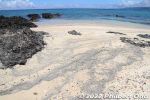
Pumice rocks are small, lightweight, porous pebbles. Floats on water. Saw it for the first time here.
|
|
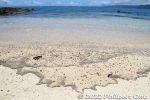
In 2021, an army of volunteers took weeks to clean up Okinawan and Amami beaches. It was almost like cleaning up an oil spill. Glad the problem has subsided.
|
|
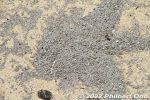
Pumice pebbles on a beach in Amami-Oshima, Kagoshima, Japan.
|
|
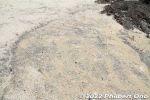
Someone had recently raked or cleaned up the pumice.
|
|
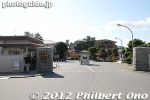
Entrance to the Naval Academy on Etajima.
|
|
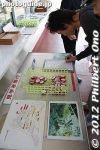
Reservations are not required, but you have to get there and sign up 5 min. before the 90-min. tour starts.
|
|

The Naval Academy conducts free guided tours of the school 3 or 4 times a day. The tour takes you around the campus and allows you to enter a few of the imposing buildings.
|
|

Map of the Naval Academy or Japanese Maritime Self Defense Force First Service School (海上自衛隊第1術科学校).
|
|
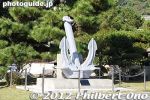
You cannot tour the Naval Academy on your own. You have to join the guided tour. There is a dress code: No miniskirts or provocative clothing by women.
|
|
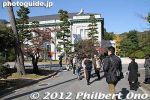
Two Naval Academy students served as our tour guide.
|
|
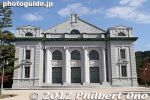
Ceremonial Hall. Built in 1917 and designed for holding ceremonies and moral education. One of the few buildings which we could enter. Etajima, Hiroshima.
|
|
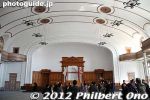
Inside the Ceremonial Hall. It can fit 2,000 people.
|
|

Stage inside the Ceremonial Hall.
|
|
|
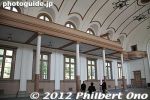
Ceremonial Hall
|
|
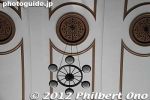
The lights look like a ship's wheel on the ceiling of the Ceremonial Hall.
|
|
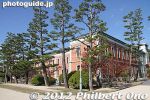
The academy's pine tree trunks grow straight up. They say that even the pine trees stand at attention at the school.
|
|
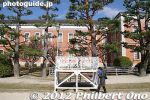
Stand for gatherings.
|
|

The academy's most distinctive building is this Students’ Hall dubbed the "Red Brick Building." We weren't allowed to go inside. Etajima, Hiroshima.
|
|
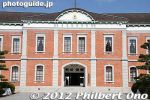
Built in 1893 and used for classrooms and living quarters for students. Today, it is part of the Officer Candidate School and used as classrooms and students' living quarters. Etajima, Hiroshima.
|
|
|
|
|
|
|
|
|
|
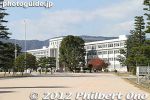
Students' Hall west wing. Built in 1938, it is used as the main students’ hall of the First Service School.
|
|

Students' Hall west wing. We weren't allowed to enter this building. The Academy also has female students, but after graduating they do not serve on navy ships. They work only on land.
|
|
|
|
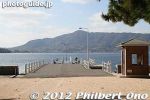
Front Pier. This is considered the school's front gate instead of the gate on land. Officer Candidate School graduates are sent off here by school staff and a military band and transferred to a training fleet anchored offshore in Etauchi inlet.
|
|
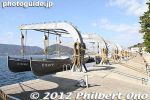
Training boats
|
|
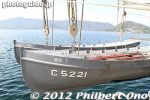
Training boats
|
|
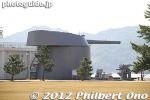
Battleship gun, life-size.
|
|
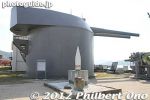
The Gun turret was a part of the main gunnery system of Battleship Mutsu and was transferred to Imperial Naval Academy for use as a study aide in 1935.
|
|
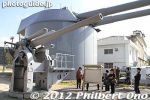
Gun turrets
|
|
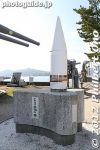
Projectile of a "Mutsu" class battleship.
|
|
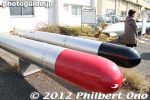
Torpedoes
|
|
|
|
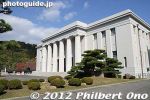
Naval History Museum on Etajima. Built in 1936, the museum is substantial with detailed exhibits tracing Japan's naval history (including the Pearl Harbor attack).
|
|
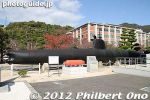
The Naval History Museum on Etajima has this outdoor display of one of the five midget submarines used in the Pearl Harbor attack.
|
|
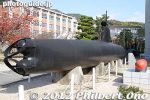
One of the five midget submarines used in the Pearl Harbor attack. On display at the Naval History Museum on Etajima island, Hiroshima.
|
|
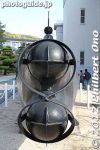
Torpedo bay of midget submarine used in Pearl Harbor attack.
|
|
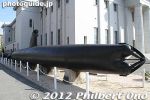
The midget sub displayed here was found in 1960 off Keehi Lagoon east of Pearl Harbor's entrance. The sub had been damaged by a depth charge attack and abandoned by its crew before it could fire its torpedoes.
|
|
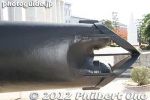
It was subsequently salvaged and restored for display at Etajima in 1962. The front part of the sub was severed, so the front part was reconstructed by a Kure shipbuilder for this display.
|
|
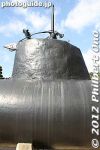
Midget sub's conning tower and periscope. The sub had only two crew members.
|
|
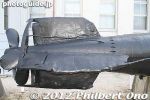
Midget sub's rudder and propeller.
|
|
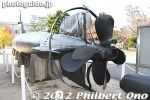
They eventually found all five subs (the fifth one was finally found in 2009) used at Pearl Harbor. Two of them are on display. One of them is here and the other is at the National Museum of the Pacific War in Fredericksburg, Texas.
|
|
|
|
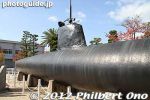
This midget sub was transported by boat from Pearl Harbor to Yokosuka (Kanagawa Pref.), then to Etajima in 1961.
|
|
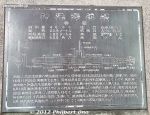
About this midget sub: Length: 23.9 meters, Weight: 46 tons, Inner diameter: 1.85 meter, Underwater speed: 19 knots (600 horsepower)
|
|
|
|
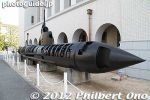
Behind the midget sub used in Pearl Harbor, another different type of midget sub is displayed.
|
|
|
|
|
|
|
|
|
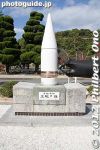
A projectile used by battleship Yamato during WWⅡ.
|
|
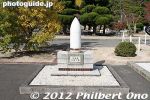
Projectile used in Japan-China War in 1894.
|
|
|
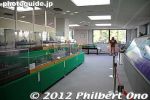
Last stop on the tour was the Etajima Club where there is a gift shop, restaurant, and this small museum on the 2nd floor.
|
|
|
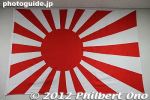
Japanese navy rising sun flag
|
|
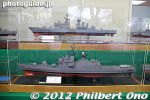
Models of navy warships.
|
|
|
|
|
|
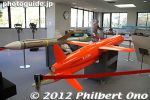
Etajima Club exhibition room.
|
|

In summer. Looking at the Hayasaki Naiko reclaimed land from the southern edge with Yamamoto-yama in the distance. This part is not yet flooded and still remains as rice paddies..
|
|

Hayasaki Naiko biotope is still largely rice paddies. For decades since 1970, rice farmers had to toil extra hard due to the water level being lower than Lake Biwa's. The paddy soil is extra watery and soft. Water has to be pumped out constantly.
|
|

What used to be a lake is a rice paddy. Imagine this to be a lake, with an embankment in front of these homes.
|
|

View of Hayasaki Naiko from the eastern edge. One stumbling block to the restoration is high land prices. Shiga needs to purchase all of the reclaimed land.
|
|

View of Hayasaki Naiko from the eastern edge. There is a committee for restoring Hayasaki Naiko, but reaching an agreement on planning and implementation takes a long time.
|
|

Rice paddy and reed bed. Special thanks to Makino Atsushi (Lake Biwa Museum) and Kurahashi Yoshihiro (Hayasaki Biotope Networking) for the tour of Hayasaki biotope.
|
|

Rice paddy and reed bed. Restoring Hayasaki Naiko may take decades. For tours (May-Nov.) of Hayasaki biotope, call in Japanese: 0749-72-2262 (Hayasaki Biotope Networking).
|
|

A stately room. The governor's desk is in the right corner.
|
|

Governor's desk in the governor's former office.
|
|
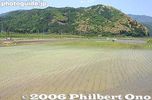
Rice paddy in May
|
|
|
|
|
|
|

Omi rice made in Shiga.
|
|
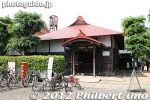
Along the Kodaira Green Road is the Kodaira Furusato-mura Village, a cluster of old homes. This is the Old Kodaira Ogawa Post Office.
|
|
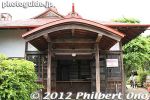
This Old Kodaira Ogawa Post Office was originally built in 1908. It was moved here in 1992. Front entrance to old post office.
|
|
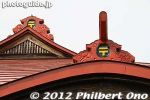
Post office symbol on the roof.
|
|
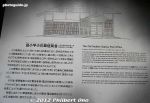
About the old post office.
|
|
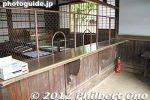
Inside the old post office.
|
|
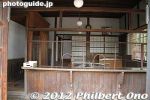
Inside the old post office.
|
|
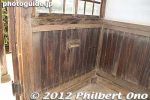
Mail drop inside the old post office.
|
|
|
|
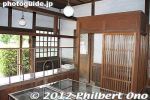
Telegram station inside the old post office.
|
|
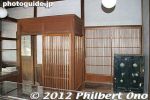
Telegram room on the left, vault on the right. 旧小平小川郵便局舎
|
|
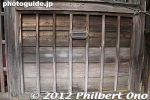
Mail drop on the outside.
|
|
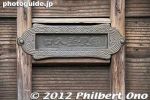
Mail drop on the outside.
|
|
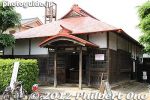
Old Ogawa Post Office at Kodaira Furusato-mura Village. Open 10 am to 4 pm, closed Mon. and 3rd Tue. of the month and Dec. 27-Jan. 5. 旧小平小川郵便局舎
|
|
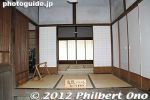
A back room of the old post office. 旧小平小川郵便局舎
|
|

Senmaida in Shiroyone, Wajima is one of Japan's most famous terraced rice paddies. It's in a remote location (10 km from central Wajima), but very picturesque with the ocean (Sea of Japan) right below it. Senmaida literally means "One-thousand rice terraces."
|
|

The smallest rice terace is only 0.2 sq. meter. The land is very fertile and minimal fertilizer is required. Senmaida is one of the most picturesque and impressive spots on the Noto Peninsula.Address: 石川県輪島市白米町99-5
|
|

Volunteers plant and harvest the rice here. The rice paddies are owned by multiple owners who meet ownership requirements.
|
|

Designated as Globally Important Agricultural Heritage Systems (GIAHS).
|
|
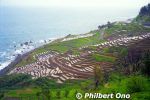
From Kanazawa Station, there are buses that go to Senmaida. Takes about 2 hours.
|
|
|
|
|
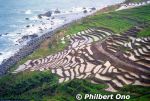
http://senmaida.wajima-kankou.jp/
|
|

写真提供:©石川県観光連盟
|
|

写真提供:©石川県観光連盟
|
|

写真提供:©石川県観光連盟
|
|

写真提供:©石川県観光連盟
|
|

写真提供:©石川県観光連盟
|
|

写真提供:©石川県観光連盟
|
|

写真提供:©石川県観光連盟
|
|

Senmaida in fall.写真提供:©石川県観光連盟
|
|
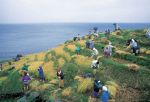
At Senmaida, harvesting rice.写真提供:©石川県観光連盟
|
|
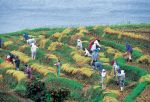
At Senmaida, harvesting rice.写真提供:©石川県観光連盟
|
|
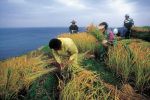
At Senmaida, harvesting rice.写真提供:©石川県観光連盟
|
|

Senmaida with candlelights during an event.写真提供:©石川県観光連盟
|
|
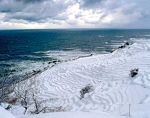
Senmaida in winter.写真提供:©石川県観光連盟
|
|

This rice paddy near the foot of Mt. Mikami and next to Mikami Shrine was used to produce the rice offering used for the Showa Emperor Hirohito's accession to the throne in 1928. Such a paddy is called Yuki Saiden. 悠紀斎田
|
|

On the fourth Sunday in May, the Yuki Saiden O-taue Matsuri, or Rice-planting Festival is held here. It starts at 10 am with a Shinto ceremony with the planters and local dignitaries in attendance in front of the rice paddy.
|
|

Rice-planting Festival Shinto ceremony. A torii stands next to the rice paddy. MAP For more info: Yasu Tourism FB
|
|

Although a Shinto priest from Mikami Shrine conducts the ceremony, the festival is organized by the Yasu Tourist Association. The rice planters and dancers are from a local rice-planting preservation group.
|
|

At 10:30 am when the ceremony was over, they proceeded to the rice paddies. Four groups of planters and dancers went to the four paddies.
|
|

First they threw bunches of rice seedlings into the paddy.
|
|
|

Everyone took off their straw sandals and went into the paddies barefoot.
|
|

Ready to sink into the paddy.
|
|

Their feet are more than ankle deep in the mud. No one lost their balance and fell into the mud.
|
|
|

When the taiko drumming and folk singing started, they started planting the rice seedlings. On the ridge, there were dancers.
|
|

This rice paddy was used to produce the rice used for a ritual called the Daijosai as part of the Showa Emperor's accession ceremonies in 1928. Selected by the Imperial Household Agency, the Yuki Saiden sacred rice paddy must be east of Kyoto. 悠�
|
|

For the Daijosai, another sacred rice paddy is also selected to the west of Kyoto. That paddy is called Suki Saiden. In 1928, it was located in Fukuoka Pref.
|
|

It is a great honor to be selected as the sacred rice paddy for an emperor's accession to the throne. The Yuki Saiden paddy for the current Emperor Akihito was in Akita Pref.
|
|

In the background is cloud-capped Mt. Mikami.
|
|

Woman planting rice at the rice-planting festival in Yasu, Shiga Prefecture.
|
|

Rice seedlings in hand.
|
|
|

On the ridges were women dancers.
|
|
|
|
|

They wear a sedge hat (suge-kasa すげ笠), red trousers (緋ばかま), wrist covers (手甲), and leggings (脚絆).
|
|

Rice-planting festival dancer, Yasu, Shiga Pref.
|
|

The rice paddy actually consists of four square paddies divided by cross-shaped ridges. When you see it from above, it looks like the kanji "ta" 田 which means rice paddy.
|
|

The Yuki Saiden rice paddy is in a scenic, rural location, with Mt. Mikami in the background. You can understand why it was selected to be the Yuki Saiden in 1928.
|
|
|
|
|
|

A gate with sacred rope
|
|

A local troupe of Taiko drummers called "Mukade Taiko." Mukade means centipede. Mt. Mikami is famous for a folk tale about a giant centipede which occupied the mountain. It was later killed by a brave warrior from Otsu.
|
|

Young children also joined in the singing.
|
|
|
|

Rice-planting festival dancer, Yasu, Shiga Pref.
|
|
|

They also had a short break.
|
|
|
|
|
|
|
|
|